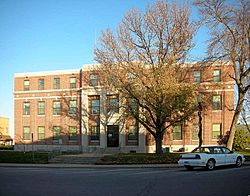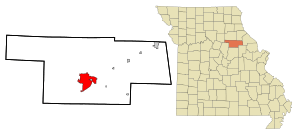Mexico, Missouri facts for kids
Quick facts for kids
Mexico, Missouri
|
||
|---|---|---|

The Audrain County Courthouse in downtown Mexico.
|
||
|
||
| Nickname(s):
Main Street of the Midwest
|
||

Location in Audrain County in the State of Missouri
|
||
| Country | United States | |
| State | Missouri | |
| County | Audrain | |
| Incorporated | March 5, 1855 | |
| Named for | Nuevo México (English: New Mexico) | |
| Government | ||
| • Type | Council-Manager | |
| Area | ||
| • Total | 12.50 sq mi (32.38 km2) | |
| • Land | 12.13 sq mi (31.43 km2) | |
| • Water | 0.37 sq mi (0.95 km2) | |
| Elevation | 761 ft (232 m) | |
| Population
(2020)
|
||
| • Total | 11,469 | |
| • Density | 945.27/sq mi (364.96/km2) | |
| Time zone | UTC-6 (CST) | |
| • Summer (DST) | UTC-5 (CDT) | |
| ZIP code |
65265
|
|
| Area code(s) | 573 | |
| FIPS code | 29-47648 | |
| GNIS feature ID | 2395107 | |
| Major airport | Mexico Memorial Airport | |
Mexico, once called New Mexico, is a city in Audrain County, Missouri, United States. It's the main city of the county, also known as the county seat. Mexico is famous for being home to the Missouri Military Academy and for hosting the annual Miss Missouri Pageant. In 2020, about 11,469 people lived here. The area around Mexico, including Audrain County, is part of the larger Columbia, Missouri metropolitan area.
Contents
History of Mexico, Missouri
Mexico was first planned in 1836 and was called "New Mexico." It was an important stop for pioneers traveling to the Republic of Texas. This is why it got its name. In 1837, it became the county seat. The word "New" was dropped after the Mexican–American War, when Texas became part of the United States.
There's a fun story about how the city got its name. It's said that early settlers found a wooden sign pointing southwest that already said "Mexico." Instead of taking it down, they just decided to name their town "Mexico." It was easier than removing the old sign!
Mexico officially became a town in 1855. It was connected by the Wabash Railroad in 1858 and the Alton Railroad in 1872. It became a city in 1874. The city is in a part of Missouri known for its bluegrass, and it used to be a big place for shipping horses and mules.
Mexico was once a major producer of fire brick, which is a special type of brick that can handle very high heat. It was even called the "Fire Brick Capital of the World." Bricks from Mexico were used to build the NASA rocket launch site in Cape Canaveral. However, this industry faced tough times, and the main brick factories closed in 2002.
Mexico is located in a central Missouri region called "Little Dixie." This area was settled by people from southern states. They brought their traditions with them. Historically, many enslaved people lived in these counties.
The historic downtown area of Mexico has a traditional courthouse at its center. It's surrounded by many old brick buildings, some from when the town was founded. Other historic places include Simmons Stables and Graceland. In the late 1970s, the city updated its downtown square with red paver bricks, old-fashioned lamp posts, and park benches.
In the 1980s, Mexico was considered for a new Saturn car plant. It didn't get the plant because it didn't have a four-lane highway. To prevent this from happening again, city leaders worked to get funding for a new four-lane highway, U.S. Route 54, which now connects the community to Interstate 70.
Mexico was also known as the "Saddle Horse Capital of the World." People from all over, including celebrities, still visit to buy riding horses. The Simmons Stables, a historic horse training center, is now being restored and is listed on the National Register of Historic Places.
Other important buildings listed on the National Register of Historic Places include the Audrain County Courthouse, Ross House, and the Arthur Simmons Stables Historic District.
Geography and Climate
Mexico is about 100 miles (160 km) northwest of St. Louis. It's located where US Route 54 crosses state routes 22 and 15. The city covers about 12.38 square miles (32.06 km²), with most of it being land and a small part being water.
Climate in Mexico
Mexico has a climate with warm summers and cold winters. Here's a quick look at the average temperatures and rainfall:
| Climate data for Mexico, Missouri (1991–2020 normals, extremes 1893–2013) | |||||||||||||
|---|---|---|---|---|---|---|---|---|---|---|---|---|---|
| Month | Jan | Feb | Mar | Apr | May | Jun | Jul | Aug | Sep | Oct | Nov | Dec | Year |
| Record high °F (°C) | 77 (25) |
80 (27) |
93 (34) |
94 (34) |
100 (38) |
106 (41) |
116 (47) |
115 (46) |
108 (42) |
98 (37) |
88 (31) |
76 (24) |
116 (47) |
| Mean daily maximum °F (°C) | 37.6 (3.1) |
42.7 (5.9) |
54.2 (12.3) |
65.9 (18.8) |
75.1 (23.9) |
83.9 (28.8) |
87.9 (31.1) |
86.6 (30.3) |
79.4 (26.3) |
67.6 (19.8) |
54.3 (12.4) |
41.9 (5.5) |
64.8 (18.2) |
| Daily mean °F (°C) | 28.4 (−2.0) |
32.8 (0.4) |
43.0 (6.1) |
54.4 (12.4) |
64.3 (17.9) |
73.4 (23.0) |
77.6 (25.3) |
75.8 (24.3) |
67.9 (19.9) |
56.0 (13.3) |
44.0 (6.7) |
33.0 (0.6) |
54.2 (12.3) |
| Mean daily minimum °F (°C) | 19.3 (−7.1) |
22.9 (−5.1) |
31.8 (−0.1) |
42.9 (6.1) |
53.5 (11.9) |
62.8 (17.1) |
67.3 (19.6) |
65.0 (18.3) |
56.4 (13.6) |
44.5 (6.9) |
33.7 (0.9) |
24.1 (−4.4) |
43.7 (6.5) |
| Record low °F (°C) | −22 (−30) |
−25 (−32) |
−12 (−24) |
11 (−12) |
27 (−3) |
39 (4) |
46 (8) |
39 (4) |
25 (−4) |
17 (−8) |
−3 (−19) |
−25 (−32) |
−25 (−32) |
| Average precipitation inches (mm) | 2.03 (52) |
2.31 (59) |
3.17 (81) |
4.68 (119) |
5.07 (129) |
5.23 (133) |
4.43 (113) |
3.90 (99) |
4.86 (123) |
2.81 (71) |
2.75 (70) |
2.28 (58) |
43.52 (1,105) |
| Average precipitation days (≥ 0.01 in) | 7.8 | 7.0 | 10.1 | 10.7 | 12.2 | 9.7 | 9.1 | 7.0 | 7.4 | 8.0 | 7.6 | 7.8 | 104.4 |
| Source: NOAA | |||||||||||||
People of Mexico, Missouri
| Historical population | |||
|---|---|---|---|
| Census | Pop. | %± | |
| 1860 | 960 | — | |
| 1870 | 2,602 | 171.0% | |
| 1880 | 3,835 | 47.4% | |
| 1890 | 4,789 | 24.9% | |
| 1900 | 5,099 | 6.5% | |
| 1910 | 5,939 | 16.5% | |
| 1920 | 6,013 | 1.2% | |
| 1930 | 8,290 | 37.9% | |
| 1940 | 9,053 | 9.2% | |
| 1950 | 11,623 | 28.4% | |
| 1960 | 12,889 | 10.9% | |
| 1970 | 11,807 | −8.4% | |
| 1980 | 12,276 | 4.0% | |
| 1990 | 11,290 | −8.0% | |
| 2000 | 11,320 | 0.3% | |
| 2010 | 11,543 | 2.0% | |
| 2020 | 11,469 | −0.6% | |
| U.S. Decennial Census 2020 Census |
|||
In 2020, Mexico had 11,469 residents. The population is made up of different groups, with about 81% white, 8% black or African-American, and smaller percentages of Native American, Asian, and other races. About 4% of the population is Hispanic or Latino.
The city has about 4,538 households. Around 27% of these households have children under 18. The average household has 2.5 people. The median age in Mexico is about 37.5 years old. This means half the people are younger than 37.5 and half are older.
Education in Mexico
Mexico was once home to Hardin College and Conservatory of Music, a college for young women founded in 1873. It closed during the Great Depression. Its large auditorium has been restored and is now used for community plays and concerts. The rest of the college buildings are now used as offices for the Mexico Public Schools. The school mascot is a bulldog.
The city is served by the Mexico Public Schools. These include Mexico Senior High School, Mexico Middle School, Hawthorne Elementary School, Eugene Field Elementary School, and McMillan Early Learning Center. There is also a private school, St. Brendan's Catholic School. For older students, there's the Mexico Area Vocational-Technical School and the Advanced Technology Center. The Missouri Military Academy is also located in Mexico.
Mexico also has a public library, which is part of the Mexico-Audrain Library District.
Media and Entertainment
Mexico is part of the Columbia/Jefferson City television market. This means residents can watch TV channels from these nearby cities. Some of the major channels available include NBC, CBS, ABC, and Fox affiliates.
For radio listeners, Mexico has four local radio stations:
- KXEO (1340 AM) plays adult contemporary music.
- KJAB (88.3 FM) plays gospel music.
- KAUD (90.5 FM) is a public radio station.
- KWWR (95.7 FM) plays country music.
You can also pick up radio stations from Columbia, Jefferson City, Moberly, and Hannibal.
Notable People from Mexico, Missouri
Many interesting people have come from Mexico, Missouri. Here are a few:
- Tom Bass, a famous horse trainer
- Cookie Belcher, a former professional basketball player
- Howard L. Bickley, a Chief Justice in New Mexico
- Click Bishop, a member of the Alaska Senate
- Christopher "Kit" Bond, a former senator and governor
- Jason Brookins, a former NFL running back for the Baltimore Ravens
- Pendleton Dudley, a journalist
- Pat Fleming, an Arizona politician
- Charles Henry Hardin, a former Missouri governor
- Edward D. "Ted" Jones, a broker
- Howard Kindig, a former Super Bowl winning NFL player
- Tyronn Lue, a head coach for the Los Angeles Clippers and former NBA player
- Martha Mears, a singer
- Prim Siripipat, a television anchor
- John Smith, an early religious leader
- Lebbeus R. Wilfley, a federal judge
- Xenophon P. Wilfley, a United States Senator
Images for kids
See also
 In Spanish: Mexico (Misuri) para niños
In Spanish: Mexico (Misuri) para niños



